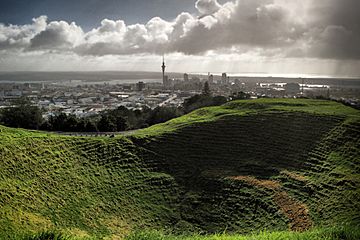Maungawhau / Mount Eden facts for kids
Quick facts for kids Maungawhau |
|
|---|---|
| Mount Eden | |

Looking into and over the crater.
|
|
| Highest point | |
| Elevation | 196 m (643 ft) |
| Geography | |
| Location | Auckland, North Island, New Zealand |
| Parent range | Auckland volcanic field |
| Geology | |
| Volcanic arc/belt | Auckland volcanic field |
Maungawhau / Mount Eden is a scoria cone in the Mount Eden suburb of Auckland, New Zealand.
Geography
The cone is a dormant volcano and its summit, at 196 metres (643 ft) above sea level, is the highest natural point on the Auckland isthmus. The majestic bowl-like crater is 50 metres (160 ft) deep. The volcano erupted from three craters 28,000 years ago, with the last eruptions from the southern crater filling the northern craters. The western face of the hill was extensively quarried. This is the site of a large ecological restoration project run by volunteers.
Naming
Maungawhau is a Māori-language name meaning 'mountain of the whau tree (Entelea arborescens)'. The name "Mount Eden" honours George Eden, 1st Earl of Auckland. The crater is named Te Ipu-a-Mataaho ('the bowl of Mataaho'); Mataaho was a deity said to live in the crater and to be the guardian of the secrets hidden in the earth.
Tourism
Maungawhau / Mount Eden attracts many tourists, as it is the highest natural point in Auckland, and provides good views in all directions over the city. There used to be a large number of tourist buses driving to the summit but these were banned in 2011. The maunga authority banned all vehicles driving to the summit in 2016, with the exception of people with limited mobility.
Other uses
From the 1950s the peak was used by the New Zealand Post Office for VHF radio communications in two buildings, several hundred metres apart, each with their own antenna farm. One building housed transmitting equipment, while the other housed receiving equipment. In the 1960s the site was staffed during the five-day working week due to the large number of valves that wore out under the stress of high power and needed frequent servicing. Typical use of the facility was for businesses e.g. taxi or delivery firms needing mobile communications to vehicles.
An underground water reservoir has been located on the northern side of Maungawhau / Mount Eden since the 1870s. The original reservoir was replaced in 1912, and a second, complementary, reservoir added in 1930. The reservoirs, recently upgraded to meet growing demand, work together to supply the Mount Eden, Epsom, One Tree Hill and Khyber Pass areas.
The trig station at the summit was used as a reference point for drawing up Auckland's suburbs. The platform was built with help from Prince Alfred's elephant. The elephant was rewarded with lollies, buns and beer.
Treaty settlement
In the 2014 Treaty of Waitangi settlement with the Tamaki Makaurau Collective of 13 Auckland iwi, the volcano was officially named Maungawhau / Mount Eden and ownership was vested to the collective. It is now co-governed by the collective and Auckland Council in common benefit of the iwi "and all other people of Auckland".
Images for kids




